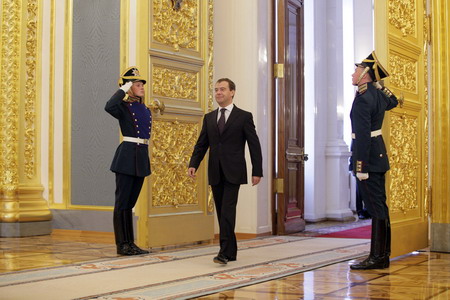World Business
Russia may diversify holdings on dollar, euro fluctuations
By Paul Abelsky and Maria Levitov (China Daily)
Updated: 2010-06-17 10:55
 |
Large Medium Small |
|
 |
|
Russian President Dmitry Medvedev arrives to deliver a speech at the Kremlin in Moscow. Medvedev has pushed for the creation of regional reserve currencies and in July produced a prototype coin for a "world currency". [Alexander Zemlianichenko / Bloomberg] |
MOSCOW - Russia may add the Australian and Canadian dollars to its international reserves for the first time after fluctuations in the US dollar and euro.
"Adding the Australian dollar is being discussed," said Alexei Ulyukayev, the central bank's first deputy chairman. "There are pros and cons. We have added the Canadian dollar but haven't yet begun operations" with the currency.
US dollars account for 47 percent of Russia's reserves, while euros make up 41 percent, British pounds 10 percent and Japanese yen 2 percent, Ulyukyaev said in November. The central bank has reduced dollars from 50 percent in 2006, when euros accounted for 40 percent and the remaining 10 percent was in yen and pounds. Russia's international reserves, the world's third biggest, reached $458.2 billion on June 4.
President Dmitry Medvedev last year suggested Russia would reduce its use of the US dollar as a reserve currency after the greenback lost 34 percent of its value against the euro in two-and-a-half years. The euro fell to a four-year low of $1.1877 on June 7 and has dropped 22 percent since Nov 25 on investor concern policymakers may fail to contain Europe's debt crisis.
Russia's push to diversify reserves "is more a result of their desire to do something in response to the extreme volatility of the dollar and the euro", said Elena Matrosova, a Moscow-based economist at BDO International, the financial consultancy that lists the central bank among its clients. The Canadian or Australian dollar "can't be truly called international reserve currencies because of their very limited liquidity", she said.
The Australian dollar traded near the strongest level since mid-May, at 86.43 US cents as of 6:40 am in London.
The Canadian and Australian dollars have been among the best performers in the past 12 months as investors speculated a recovering global economy would increase demand for the countries' raw materials. The Canadian dollar has gained 10 percent against the US currency and 23 percent versus the euro during that period. The Australian dollar is up 8.6 percent and 21 percent, respectively.
| ||||
Central Bank Chairman Sergey Ignatiev said on May 27 that Russia hadn't changed the currency structure of its reserves after year-end figures showed Bank Rossii increased the portion held in dollars.
The US dollar may account for more than half of Russia's foreign currency reserves by the end of this year, Paris-based BNP Paribas estimated last month.
The rouble has gained almost 11 percent against the euro and 0.2 percent versus the dollar in the past 12 months. The Russian currency strengthened for a fifth day against the greenback, climbing 0.7 percent to 31.1450 for its longest winning streak in two months.
Russia had a net capital inflow of about $3 billion in May after an inflow of between $3 billion and $4 billion in the previous month, said Ulyukayev.
"There was a small capital inflow of about $3 billion in May, according to preliminary calculations," he said.
The Russian government forecasts no net capital inflow this year after outflows of $52.4 billion in 2009.
Bloomberg News



